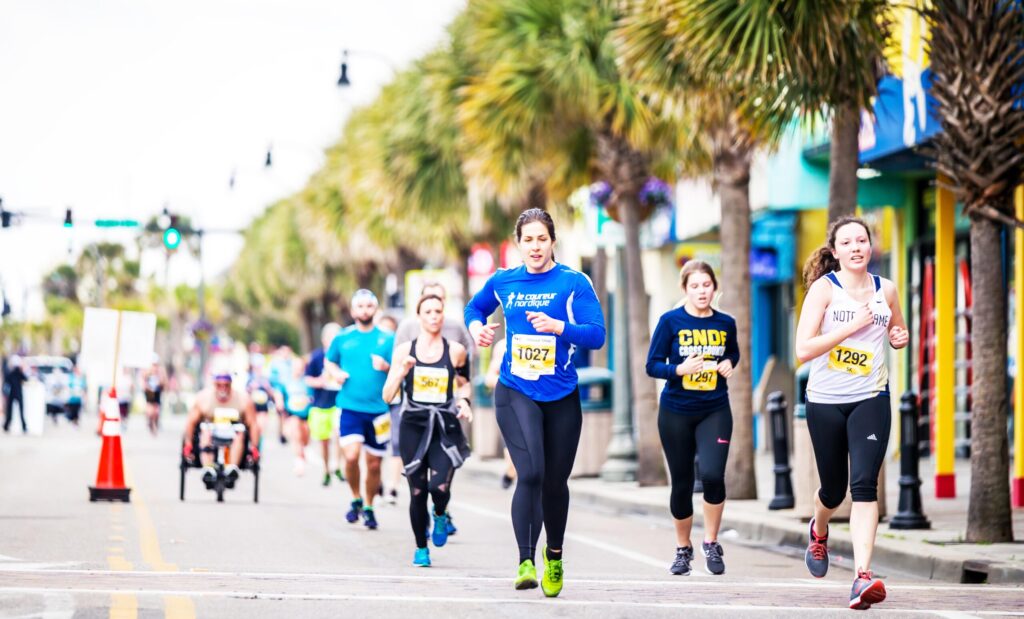
Discover the Joy of Running 26.2 Miles and Wondering Why You Signed Up in the First Place
Running marathons is an accomplishment that requires discipline, dedication, and mental toughness. In the United States, the popularity of marathons has grown tremendously over the years, with thousands of runners participating in races nationwide annually.
While the physical and mental challenges of completing a marathon are significant, the rewards are equally satisfying. From personal satisfaction to charitable contributions, running a marathon in the USA provides a unique opportunity to test one’s limits and give back to the community.
Here are the marathons, along with their distance and why they are challenging:
- Boston Marathon: The Boston Marathon is a 26.2-mile race that is notoriously difficult due to its hilly terrain, particularly in the later stages of the race. The weather conditions can also be unpredictable, with runners having to contend with everything from cold rain to extreme heat.
- New York City Marathon: The New York City Marathon is also a 26.2-mile race, and it is known for its challenging course that winds through all five boroughs of New York City. The race includes several significant inclines, including the infamous “Heartbreak Hill” in the Bronx, which can be particularly challenging for runners.
- Chicago Marathon: The Chicago Marathon is another 26.2-mile race, and it is known for its fast and flat course that attracts many elite runners. However, the race can be challenging due to its often unpredictable weather conditions, ranging from extreme heat to cold rain and wind.
- Marine Corps Marathon: The Marine Corps Marathon is a 26.2-mile race run through Arlington, Virginia, and Washington, D.C. streets. The race includes several significant inclines, including the steep climb up the infamous “Mile 20 Hill,” which can be particularly challenging for runners.
- Walt Disney World Marathon: The Walt Disney World Marathon is a 26.2-mile race that winds through the various theme parks and resorts of Walt Disney World in Orlando, Florida. While the course is relatively flat, the race can be challenging due to the heat and humidity in Florida, particularly for runners not used to running in those conditions.
- Los Angeles Marathon: The Los Angeles Marathon is another 26.2-mile race known for its challenging course, which includes several significant inclines and declines as it winds through the streets of Los Angeles. The race can also be difficult due to the often unpredictable weather conditions ranging from hot and dry to cold and wet.
- Houston Marathon: The Houston Marathon is a 26.2-mile race known for its relatively flat course, making it a popular choice for runners looking to set a personal best time. However, the race can be challenging due to the often hot and humid conditions in Houston, which can be challenging for runners not used to running in those conditions.
- Philadelphia Marathon: The Philadelphia Marathon is a 26.2-mile race known for its challenging course, which includes several significant inclines and declines as it winds through the streets of Philadelphia. The race can also be difficult due to the often cold and windy conditions in Philadelphia in November when the race is typically held.
- San Francisco Marathon: The San Francisco Marathon is a 26.2-mile race known for its challenging course, which includes several significant hills as it winds through the streets of San Francisco. The race can also be difficult due to the often cold and foggy conditions in San Francisco, making it challenging for runners to maintain their pace.
Did you know?
Marathons were only sometimes 26.2 miles long. The first modern Olympic marathon in Athens in 1896 had a distance of about 25 miles, and it was in the 1908 Olympics in London that the 26.2-mile distance was standardized for modern marathons.
The route for the 1908 marathon was extended to include a loop around the royal castle, adding an extra 385 yards to the race so that the finish line could be placed in front of the royal box. This distance became the official length of a marathon, and it has remained unchanged ever since.
A little history:
The origins of marathons date back to ancient Greece, where the story goes that in 490 BC, a soldier named Pheidippides ran from the city of Marathon to Athens to deliver news of the Greek victory over the Persians.
According to legend, Pheidippides collapsed and died immediately after delivering the message, and this feat of endurance inspired modern-day marathons.

The first modern Olympic marathon was held in Athens in 1896, and it was won by a Greek runner named Spyridon Louis. The marathon became a popular event in the Olympic Games, and in the early 20th century, the Boston Marathon was established as the first major marathon in the United States.
Over time, marathons grew in popularity and became more accessible to the general public.
Thousands of marathons are held worldwide each year, with millions of runners participating in these events for personal accomplishment, fitness, and charity causes.



